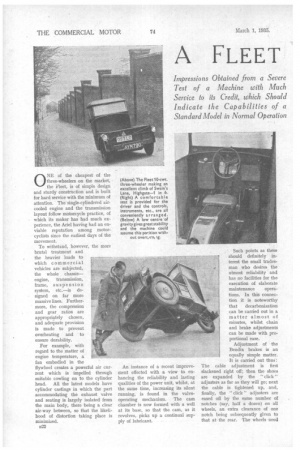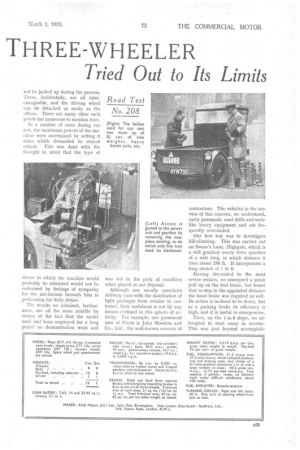A FLEET THREE-WHEELER
Page 36

Page 37

Page 38

If you've noticed an error in this article please click here to report it so we can fix it.
Tried Out to Its Limits
Impressions Obtained from a Severe Test of a Machine with Much Service to its Credit, which Should Indicate the Capabilities of a Standard Model in Normal Operation
0 NE of the cheapest of the three-wheelers on the market, the Fleet, is of simple design and sturdy construction and is built for hard service with the minimum of attention. The single-cylindered aircooled engine and the transmission layout follow motorcycle practice, of which its maker has had much experience, the Ariel having had an enviable reputation among motorcyclists since the earliest days of the movement.
To withstand, however, the more brutal treatment and the heavier loads to which commercial vehicles are subjected, the whole chassis— engine, transmission, frame, suspension system, etc.—is designed on far more massive lines. Furthermore, the compression and gear ratios are appropriately chosen, and adequate provision is made to prevent overheating and to ensure durability.
For example, with regard to the matter of engine temperature, a fan embodied in the flywheel creates a powerful air current which is impelled through suitable cowling on to the cylinder head. All the latest models have cylinder castings in which the part accommodating the exhaust valve and seating is largely isolated from the main body, there being a clear air-way between, so that the likelihood of distortion taking place is minimized.
1322 An instance of a recent improvement effected with a view to enhancing the reliability and lasting qualities of the power unit, whilst, at the same time, increasing its silent running, is found in the valveoperating mechanism. The cam chamber is now formed with a well at its base, so that the cam, as it revolves, picks up a continual supply of lubricant. Such points as these should definitely interest the small tradesman who desires the utmost reliability and has no facilities for the execution of elaborate maintenance operations. In this connection it is noteworthy that decarbonization can be carried out in a matter almost of minutes, whilst chain and brake adjustments can be made with proportional ease.
Adjustment of the Bendix brakes is an equally simple matter. It is carried out thus The cable adjustment is first slackened right off; then the shoes are expanded by the " click " adjusters as far as they will go; next the cable is tightened up, and, finally, the " click " adjusters are eased off by the same number of notches (say, half a dozen) on all wheels, an extra clearance of one notch being subsequently given to that at the rear. The wheels need
riot be jacked up during the process. These, incidentally, are all interchangeable, and the driving wheel can be detached as easily as the others. There are many other such points too numerous to mention here.
In a number of cases during our test, the maximum powers of the machine were ascertained by setting it tasks which demanded its utmost output. This was done with the thought in mind that the type of driver to which the machine would probably be entrusted would not be restrained by feelings of sympathy for the mechanism beneath him in performing his daily duties: The results we obtained, furthermore, are all the more reliatile by reason of the fact that the model used had been employed for a long period on demonstration work and was not in the pink of condition when placed at our disposal.
Although one usually associates delivery vans with the distribution of light packages from retailer to customer, their usefulness is not by any means confined to this sphere of activity. For example, one prominent user of Fleets is John Mowlem and Co., Ltd., the well-known concern of contractors. The vehicles in the service of this concern, we understand, carry pneumatic road drills and suchlike heavy equipment and are frequently overloaded.
Our first test was to investigate hill-climbing. This was carried out on Swain's Lane, Highgate, which is a stiff gradient nearly three quarters of a mile long, in which distance it rises about 250 ft. It incorporateS a long stretch of 1 in 6.
Having descended to the most severe section, we attempted a quick pull up on the foot brake, but found that to stop in the appointed distance the hand brake was required as well. Its action is inclined to be fierce, but as a; parking brake its efficiency is high, and it is useful in emergencies.
Then, up the 1-in-6 slope, we attempted to start away in reverse. This was just beyond accomplisl ment, with 10 cwt. on board ; the feat was performed, however, without the passenger. A non-stop ascent was then made. Approaching the hill at 20 m.p.h., we lost speed quickly, dropping into second gear at about 18 m.p.h. In this gear the 1-in-6 section was reached, when the speed fell and first gear was engaged, the climb being completed at about 10 m.p.h.
Afterwards, a second ascent was made, the machine again being stopped on the 1-in-6 section and this time restarted forwards. First gear is an appreciably lower ratio than reverse, and the get-away in this case was successfully made with full load.
Accelerative capabilities on the level are revealed in an accompany ing . graph. Obviously, with only three speeds and a rather low power output for the weight, the ratios must be. widely spaced. This results in it being necessary to run the engine up to rather uncomfortably high revolu. tions before making the change, when rapid acceleration is demanded. Indeed, the crankshaft-speed obtainable is surprising, in view of the pulling powers at low speed. Accelerating from 10 m.p.h. in top gear, one can almost count the explosions, yet velocity is gained quickly and steadily. Although these tests were carried out after a spell of "fiat-out" speed-38-40 mph.—no pinking, knocking or symptoms of overheating were discernible.
Retardation was found to be good, but limited by a " snaking " motion which occurred when the brakes were applied with excessive vigour. It seems that the stability of the steer
ing, in such circumstances, is rather too dependent upon the accuracy of brake adjustment.
The foregoing tests were included in that for petrol consumption, because the daily round of such a machine would probably consist of just as many stops and starts as were made on this occasion, and, possibly, the equivalent in hill-climbing. In addition, Barnet Hill (from the south) was climbed and some fast main-road travelling thrown in. Thus the return of 32 m.p.g. which we obtaMed may be used with safety as a basis for calculations, and, undoubtedly, could be greatly improved upon on a non-stop run.
The Fleet vehicle is as easy to drive as it is to maintain, and the engine appeared to be a certain starter. Taxed at only £4 per annum, consuming fuel and oil sparingly, and low in first cost, as a boxvan or an open truck, this machine seems ideally suited for the economical transport of loads not exceeding 10 cwt., and likely to stand up well to hard driving and rough conditions.




























































































